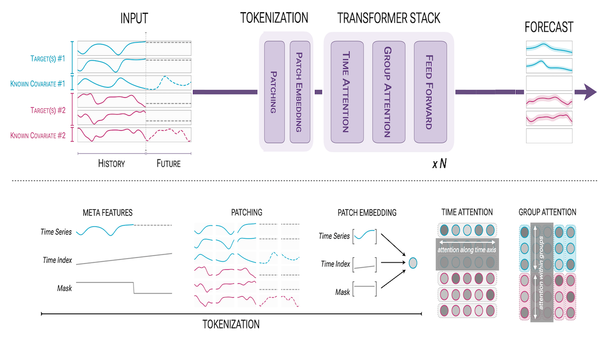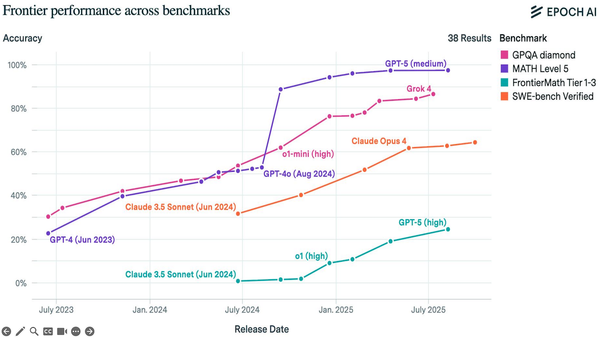Generating persistent, editable 3D worlds: Exploring the limits of small synthetic datasets
OpenAI’s GPT-5.1, a more personalizable agentic model. Project FETCH’s use of Claude to program robots. Baidu’s new VL model that tops Gemini Pro and GPT-5. OpenAI liable for copyrighted song lyrics.

In today’s edition of Data Points, you’ll learn more about:
- OpenAI’s GPT-5.1, a more personalizable agentic model
- Project FETCH’s use of Claude to program robots
- Baidu’s new VL model that tops Gemini Pro and GPT-5
- OpenAI liable for copyrighted song lyrics
But first:
World Labs debuts Marble, a 3D world generator with editing tools
The AI startup founded by Fei-Fei Li launched its first commercially available generative world model that converts text prompts, photos, videos, 3D layouts, or panoramas into editable, downloadable 3D environments. Unlike competitors like Decart, Odyssey, and Google’s Genie, Marble creates persistent 3D spaces that users can export as Gaussian splats, meshes, or videos, rather than generating worlds on-the-fly. The model includes AI-native editing tools and a hybrid 3D editor called Chisel that lets users block out structures in space before AI fills in the details, giving developers more control over generated environments. The model can be used in gaming, visual effects for film, and virtual reality, with developers able to export assets into game engines like Unity or Unreal Engine. Marble offers four subscription tiers ranging from free (four generations) to $95 per month (75 generations with all features and commercial rights). (TechCrunch)
How SYNTH trains small AI models with 50 times less data
French researchers released a synthetic dataset built from 50,000 Wikipedia articles that trains language models specifically for reasoning rather than using general web text. The dataset includes diverse problem types, from math exercises to creative writing, with structured reasoning traces that help models learn more efficiently than traditional pretraining approaches. Using SYNTH, the team trained two small models on fewer than 200 billion tokens: Baguettotron (321 million parameters) achieved state-of-the-art results in its class on major benchmarks including MMLU and gsm8k, while Monad (56 million parameters) became what researchers claim is the smallest viable language model. The project required only 1,000 H100 hours for final training runs, demonstrating that synthetic data focused on reasoning can produce competitive models at dramatically lower computational costs than conventional approaches. SYNTH is released under open licenses, with all synthetic outputs traced back to verifiable Wikipedia sources. (Pleias)
OpenAI updates GPT-5 in ChatGPT and the API
OpenAI released GPT-5.1, a new model that dynamically adjusts its reasoning time based on task complexity. The model includes a “no reasoning” mode for faster responses on simple tasks, extended prompt caching for up to 24 hours, and two new tools: apply_patch for more reliable code editing and a shell tool for running command-line operations. Early testing showed GPT-5.1 runs 2-3 times faster than GPT-5 on everyday tasks while using about half as many tokens, and it achieved 76.3 percent accuracy on SWE-bench Verified, outperforming GPT-5’s 72.8 percent. The model is available to all paid API users at the same pricing as GPT-5, with specialized variants gpt-5.1-codex and gpt-5.1-codex-mini optimized for long-running coding tasks. (OpenAI)
Anthropic “Project Fetch” shows Claude halves non-experts’ time to program unfamiliar robotics tasks
Anthropic divided eight of its researchers into two teams (one with Claude access, one without) and asked them to program robotic dogs to fetch beach balls. Team Claude accomplished more tasks and completed them in about half the time, with only the AI-assisted team making substantial progress toward fully autonomous ball retrieval. Claude particularly excelled at helping teams connect to hardware and access sensor data. However, the AI-assisted team wrote roughly nine times more code. The study shows how AI models are beginning to bridge digital and physical worlds through robotics, suggesting that systems capable of independently interacting with previously unknown hardware may arrive soon. (Anthropic)
Baidu unveils lightweight vision-language reasoning model
Baidu released ERNIE-4.5-VL-28B-A3B-Thinking, a multimodal AI model that activates only 3 billion parameters while matching larger flagship models on various benchmarks. The model was trained using multimodal reinforcement learning techniques on visual-language reasoning data to improve alignment between vision and text. Key capabilities include chart analysis, STEM problem-solving from images, visual grounding with bounding box detection, and video understanding with temporal awareness. The model’s “Thinking with Images” feature enables it to autonomously zoom in on image regions and call external tools like image search to identify objects and retrieve information. The model is available with open weights under Apache License 2.0. (Baidu)
German court rules OpenAI violated copyright law by training on song lyrics
The Munich court found that OpenAI infringed copyright by training its AI models on protected lyrics from nine German songs, including hits by best-selling musician Herbert Groenemeyer. The case was brought by GEMA, a German music rights society representing composers, lyricists, and publishers. OpenAI had argued that its language models don’t store specific training data and that users, not the company, should be liable for any copyrighted output generated through prompts, but the court rejected this defense. The ruling could set a precedent in Europe for how AI companies use copyrighted materials, adding to growing global pushback from artists against data scraping. (Reuters)
A special offer for our community
DeepLearning.AI just launched the first-ever subscription plan for our entire course catalog! As a Pro Member, you’ll immediately enjoy access to:
- Over 150 AI courses and specializations from Andrew Ng and industry experts
- Labs and quizzes to test your knowledge
- Projects to share with employers
- Certificates to testify to your new skills
- A community to help you advance at the speed of AI
Enroll now to lock in a year of full access for $25 per month paid upfront, or opt for month-to-month payments at just $30 per month. Both payment options begin with a one week free trial. Explore Pro’s benefits and start building today!
Still want to know more about what matters in AI right now?
Read this week’s issue of The Batch for in-depth analysis of news and research.
This week, Andrew Ng discussed hype about AI’s capabilities, emphasizing that while AI is impressive, it still has significant limitations and requires customization for specific tasks.
“Yes, AI is amazingly intelligent, and I’m thrilled to be using it every day to build things I couldn’t have built a year ago. At the same time, AI is still incredibly dumb, and I would not trust a frontier LLM by itself to prioritize my calendar, carry out resumé screening, or choose what to order for lunch — tasks that businesses routinely ask junior personnel to do.”
Read Andrew’s full letter here.
Other top AI news and research stories we covered in depth:
- Character AI and OpenAI implemented policy changes to protect younger and vulnerable users, aiming for safer and more responsible chatbot interactions.
- HunyuanImage-3.0 improved image generation by using reinforcement learning and thinking tokens to better interpret and respond to prompts.
- The State of AI Report 2025 highlighted that AI’s barriers were not technological but social and material, marking a pivotal year for AI’s industrial adoption.
- Amazon’s Chronos-2 advanced forecasting by sorting out tangled variables to make better predictions across multiple time series.




